Cotton Picker Fire Risk Analysis and Dynamic Threshold Setting Using Multi-Point Sensing and Seed Cotton Moisture
Abstract
1. Introduction
1.1. Research Background and Questions
1.2. Research Objectives and Contributions
- We proposed and validated a dynamic, multi-tiered temperature threshold system based on key component characteristics and seed cotton moisture content. Differentiated thresholds accurately match fire risks across regions, resolving false alarms and missed detections while significantly improving the system’s adaptability.
- This study quantitatively elucidates for the first time how seed cotton moisture content influences combustion characteristics. It defines critical parameters such as open flame temperature and smoldering temperature at different moisture levels, generating a threshold table directly configurable in controllers. This provides clear parameter support for the engineering implementation of fire monitoring systems.
- This research shifts cotton harvester fire management from reactive post-fire alarms to a predictive paradigm that enables proactive intervention before thresholds are triggered. We also propose developing an intelligent early warning system that integrates real-time moisture sensing, airflow monitoring, and other multi-source information.
2. Materials and Methods
2.1. Experimental Materials
2.1.1. Friction Characteristics of Seed Cotton
2.1.2. Definition and Measurement of Seed Cotton Moisture Content
2.1.3. Comparison and Improvement of Fire Monitoring Methods for Cotton Pickers
2.1.4. Method for Establishing Differentiated Thresholds for Different Components of Cotton Pickers
- (1)
- Fire Early Warning for Picking Heads: A friction test rig was used to replicate actual load and blockage conditions, measuring the critical temperature that triggers smoldering combustion. Combined with numerical simulation (ANSYS 2022R1) to predict the time required to reach this temperature under typical rotational speeds and loads, dual temperature-time thresholds were established for proactive early warning.
- (2)
- Fire Warning for Cotton Picker Conveyor Pipes: These pipes involve high-speed pneumatic solid–liquid transport, making surface temperature measurement challenging. Early-stage smoldering in seed cotton is more sensitive to gaseous products, so CO is the primary monitoring parameter. Thresholds were adjusted based on CO sensor alarm ranges. A cotton conveyor pipe test rig was constructed, using burning seed cotton moving through the pipe to obtain wall temperatures and establish thresholds for temperature monitoring.
- (3)
- Early Fire Warning for Cotton Picker Hopper: As a relatively static heat storage scenario, the hopper exhibits slow heat evolution and large thermal scales for seed cotton. Small-scale combustion tests using infrared surface temperature measurement defined the minimum temperatures for smoldering and flaming seed cotton, creating a localized threshold table. Based on this analysis of fire mechanisms for different components, we designed the following targeted experiments.
2.2. Seed Cotton Open-Flame Test
2.3. Seed Cotton Smoldering Test
2.4. Friction Heat Generation Test of Seed Cotton from Cotton Picker Heads
2.5. Test of the Cotton Burning Temperature on the Cotton Conveyor Pipe’s Wall Surface in a Cotton Picker
3. Results and Discussion
3.1. Results of the Open-Flame Test on Seed Cotton
3.2. Seed Cotton Smoldering Test Results
3.3. Heat Generation from Seed Cotton Friction and Simulation Test Results
3.4. Test Results for Cotton Conveyor Pipe Wall Temperature
3.5. Test Uncertainty and Sensitivity Analysis
3.5.1. Test Uncertainty Analysis
Calculation of Standard Deviation and Coefficient of Variation
Sources of Uncertainty and Control
- (1)
- Sensor Error: The CO sensor (JX-CO-103) has an accuracy of ±5% of full scale (F.S.), but the infrared temperature sensor (FST600-400A) has an accuracy of ±3 °C with respect to the measured value. Through on-site CO sensor verification and three-point infrared sensor calibration, this study decreased such inaccuracies.
- (2)
- Operating Condition Control Error: In friction tests, the centrifugal fan speed was adjusted to control the air velocity in the cotton feed pipe and the extractor’s insertion depth (3 cm), with an error of ≤±5%. A moisture meter (ZTW1602A, Chint, Yueqing, China) was used to control the moisture content of seed cotton, with an inaccuracy of ≤±0.5%.
- (3)
- Human Operational Error: A timer regulates the 0.3 s contact time with the little flame in the seed cotton open-flame test. To reduce subjective mistakes, two test personnel cross-verify the combustion status during the smoldering test.
- (4)
- Pattern of Error Reduction for Multiple Measurements: The standard error of the mean is calculated using the standard deviation calculation logic developed in Section 3.5.1 and the data from 10 repeated trials provided in Table 3 (standard error = standard deviation of a single measurement/number of repetitions). For instance, the standard error of the mean for the seed cotton group with MC < 9% (mean ignition temperature 324.4 °C, standard variation 3 °C) is 3/10 ≈ 0.95 °C. The real precision decreases from ±3 °C per measurement to within ±1 °C after averaging. Similarly, the average precision for the two groups is ±1.1 °C and ±1.7 °C, respectively, based on data from Table 2 for the seed cotton groups with MC 9–12% (standard deviation 3 °C) and the MC 12–15% seed cotton group (standard deviation 3 °C). The low dispersion results in Table 7 (MC < 9% group CV = 0.92% and MC 12–15% group CV = 1.68%) are consistent with this.
3.5.2. Sensitivity Analysis of Test Parameters
4. Conclusions
- (1)
- This study tackles the fundamental problem in cotton picker fire monitoring, which is the persistently high false alarm rates caused by traditional fixed temperature thresholds that are unable to adjust to the dynamic fluctuations in seed cotton moisture content (MC) and the various heat generation characteristics of the picking head, cotton conveyor tube, and cotton bin components. We created a dynamic threshold calibration system that connects seed cotton humidity and multi-point monitoring. In order to thoroughly examine the fire hazard characteristics of the three crucial parts—the picking head, cotton conveyor tube, and cotton bin—multi-scenario empirical tests, open-flame, smoldering, and friction bench tests on seed cotton, as well as numerical simulation techniques, were integrated. The drawbacks of conventional monitoring systems that depend on consistent, fixed thresholds are addressed by this method.
- (2)
- This study identified the key factors influencing and quantified the heat generation and combustion characteristics of seed cotton friction. Under simulated field cotton-clogging conditions (seed cotton density: 120 kg/m3), the friction heat power between the picker and seed cotton reached 7.26 × 103 W. A single 0.1 s friction event generates 326.7 J of effective heat, sufficient to raise the temperature of 30 g of seed cotton by 8.4 °C. When this heat accumulates continuously for 10 s, the seed cotton temperature approaches the 289 °C smoldering ignition threshold of the picking head, confirming that accumulated friction heat is the core cause of cotton picker fires. Simultaneously, through the pretreatment of seed cotton samples and standardized experimental variables, fluctuations in material reflectance coefficients were effectively eliminated from infrared measurements, providing a reliable data foundation for quantifying fire risk analysis.
- (3)
- This study advances fire risk management for cotton pickers from a reactive response model to a predictive proactive model. The proposed thresholds enable the system to perform anticipatory interventions before catastrophic consequences occur. However, certain research limitations exist. Future work will focus on integrating this strategy into commercial cotton pickers and conducting field validation under diverse agronomic conditions. This experiment referenced the picker parameters of the Boshiran 4MZ-6 cotton picker. However, field cotton pickers vary widely in models (e.g., John Deere, Case); differences in picker tooth count, rotational speed range, cotton feed tube diameter, and component materials may lead to variations in the rates of friction heat generation and wall temperature distributions. Subsequent collaboration with agricultural machinery manufacturers will involve conducting multi-model threshold validation tests to establish a machine-model threshold matching table, enhancing the universality of the threshold system. Furthermore, integrating multi-source information such as real-time moisture sensing and airflow monitoring to build a more robust intelligent early warning system represents a promising direction for future research.
Author Contributions
Funding
Institutional Review Board Statement
Informed Consent Statement
Data Availability Statement
Conflicts of Interest
References
- Shi, M.; Gao, X.; Zhang, W.; Ran, K.; Zhong, L.; Xu, L. Current Status and Prospects of Key Technologies for Cotton Pickers. Trans. Chin. Soc. Agric. Mach. 2025, 56, 167–183. [Google Scholar]
- Yu, B.; Zhang, H.; Ma, W.; Yang, Z. Design and Experimental Study of Detection Circuit for Fire Detection and Early Warning Device in Cotton Pickers. Xinjiang Agric. Reclam. Sci. Technol. 2015, 38, 33–35. [Google Scholar]
- Wang, J.; Yu, B.; Liu, Q.; Zhang, H.; Ma, W.; Zhang, X. Analysis of Detection Performance of Fire Detection Device in Cotton Pickers. J. Shihezi Univ. (Nat. Sci. Ed.) 2016, 34, 649–653. [Google Scholar] [CrossRef]
- Miao, Z.; Wei, C. Development of a Spark Detection System for Cotton Conveying Pipes in Cotton Pickers. Autom. Instrum. 2016, 37, 50–53. [Google Scholar] [CrossRef]
- Li, Y. Research on Working Condition Monitoring and Typical Fault Diagnosis of Cotton Pickers. Master’s Thesis, China Academy of Agricultural Mechanization Sciences, Beijing, China, 2017. [Google Scholar]
- Han, K.; Hao, F.; Miao, Z.; Han, Z.; Gan, X.; Li, B.; Yu, P. Design and Development of a CAN-Bus-Based Monitoring System for Cotton Picker Operational Status. Agric. Mach. 2019, 9, 91–97. [Google Scholar] [CrossRef]
- Wu, Y.; Chen, K.; Yan, K.; Zhou, X.; Shi, Z. Design Research on Safety Detection and Early Warning System for Cotton Pickers. Light Ind. Sci. Technol. 2019, 35, 89–90+141. [Google Scholar]
- Li, W.; Zhang, J.; Wang, C.; Yu, T.; Zhang, H. Current Status and Prospects of Fire Monitoring Systems for Cotton Pickers. Xinjiang Agric. Mech. 2020, 3, 25–28. [Google Scholar] [CrossRef]
- Shi, Z.; Han, C.; Xue, Y. Review of Research on Fire Occurrence Mechanisms in Cotton Pickers. South. Agric. Mach. 2023, 54, 1–5. [Google Scholar]
- Shi, Z.; Wu, F.; Han, C.; Song, D. Research on Fire Detection of Cotton Picker Based on Improved Algorithm. Sensors 2025, 25, 564. [Google Scholar] [CrossRef] [PubMed]
- Shi, Z.; Wu, F.; Han, C.; Song, D.; Wu, Y. Detection Model for Cotton Picker Fire Recognition Based on Lightweight Improved YOLOv11. Agriculture 2025, 15, 1608. [Google Scholar] [CrossRef]
- Zhang, W.; Zhao, B.; Gao, S.; Zheng, Y.; Zhou, L.; Liu, S. Development of Cotton Picker Fire Monitoring System Based on GA-BP Algorithm. Sensors 2023, 23, 5553. [Google Scholar] [CrossRef] [PubMed]
- Bao, R.; Zhang, Y.; Gu, H.; Huang, H. Thermal Analysis Study on the Spontaneous Combustion Risk of Cotton. Fire Sci. Technol. 2012, 31, 100–103. [Google Scholar]
- Hagen, B.C.; Frette, V.; Kleppe, G.; Arntzen, B.J. On set of smoldering in cotton: Effects of density. Fire Saf. J. 2011, 46, 73–80. [Google Scholar] [CrossRef]
- Hagen, B.C. Ignition of smoldering in cotton: 3D-heat-transfer-modeling. Am. Sci. Res. J. Eng. Technol. Sci. 2018, 50, 66–87. Available online: https://asrjetsjournal.org/American_Scientific_Journal/article/view/4530 (accessed on 19 August 2025).
- Ohlemiller, T.J. Smoldering Combustion Hazards of Thermal Insulation Materials; NBSIR81-2350; National Bureau of Standards(NIST): Gaithersburg, MD, USA, 1981. [Google Scholar] [CrossRef]
- Hagen, B.C. On Set of Smoldering and Transition to Flaming Fire. Ph.D. Thesis, University of Bergen, Bergen, Norway, 2012. [Google Scholar]
- State Administration for Market Regulation of the People’s Republic of China, Standardization Administration of China. GB/T 1103.1-2021; Cotton—Part 1: Fine-Staple Cotton Processed by Saw Gin. China Standards Press: Beijing, China, 2021. [Google Scholar]
- Liu, C.; Gulibahar, T.; Maimaitiming, A.; Hu, G. Dynamic Characteristics Analysis of Rigid-Flexible Coupling in Flexible Vertical Picker-Type Cotton Harvesting System Based on ADAMS. Agric. Mech. Res. 2025, 47, 36–42. [Google Scholar] [CrossRef]
- Nur Aihamati, W.; Yisifujiang, S.; Zhao, T.; Maimaitiming, A. Optimal Design of Structural Parameters and Finite Element Analysis of Vertical Plucking Spindles. Jiangsu Agric. Sci. 2020, 48, 206–213. [Google Scholar] [CrossRef]
- Fang, L.; Zhang, R.; Duan, H.; Chang, J.; Zeng, Z.; Qian, Y.; Hong, M. Resistive Sensing of Seed Cotton Moisture Regain Based on Pressure Compensation. Sensors 2023, 23, 8421. [Google Scholar] [CrossRef] [PubMed]
- Abreu, F.F.; Rodrigues, L.H.A. Monitoring mini-tomatoes growth: Anon-destructive machine vision-based alternative. Agric. Agric. Agric. Eng. J. 2022, 58, 123–135. [Google Scholar] [CrossRef]
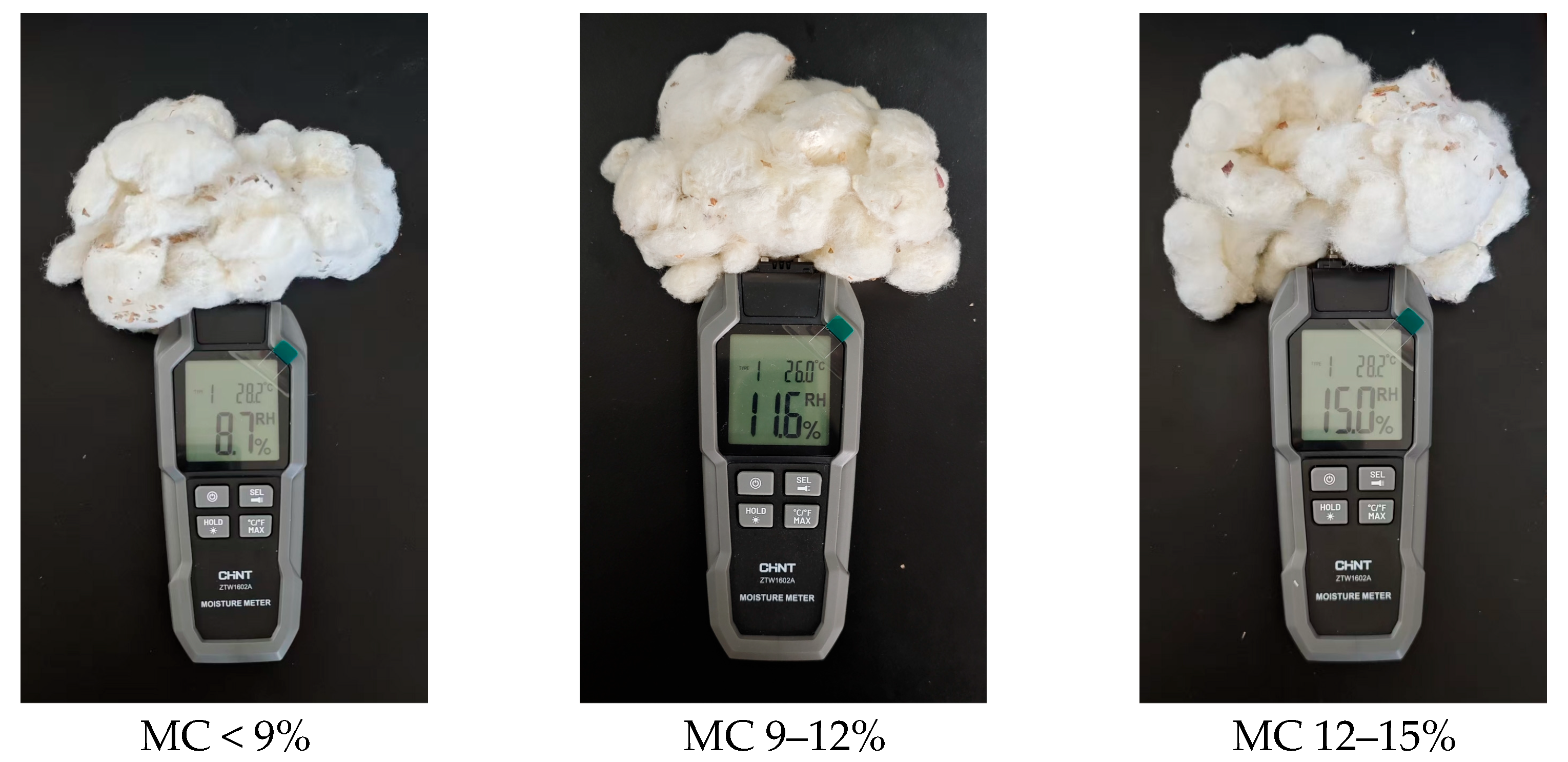


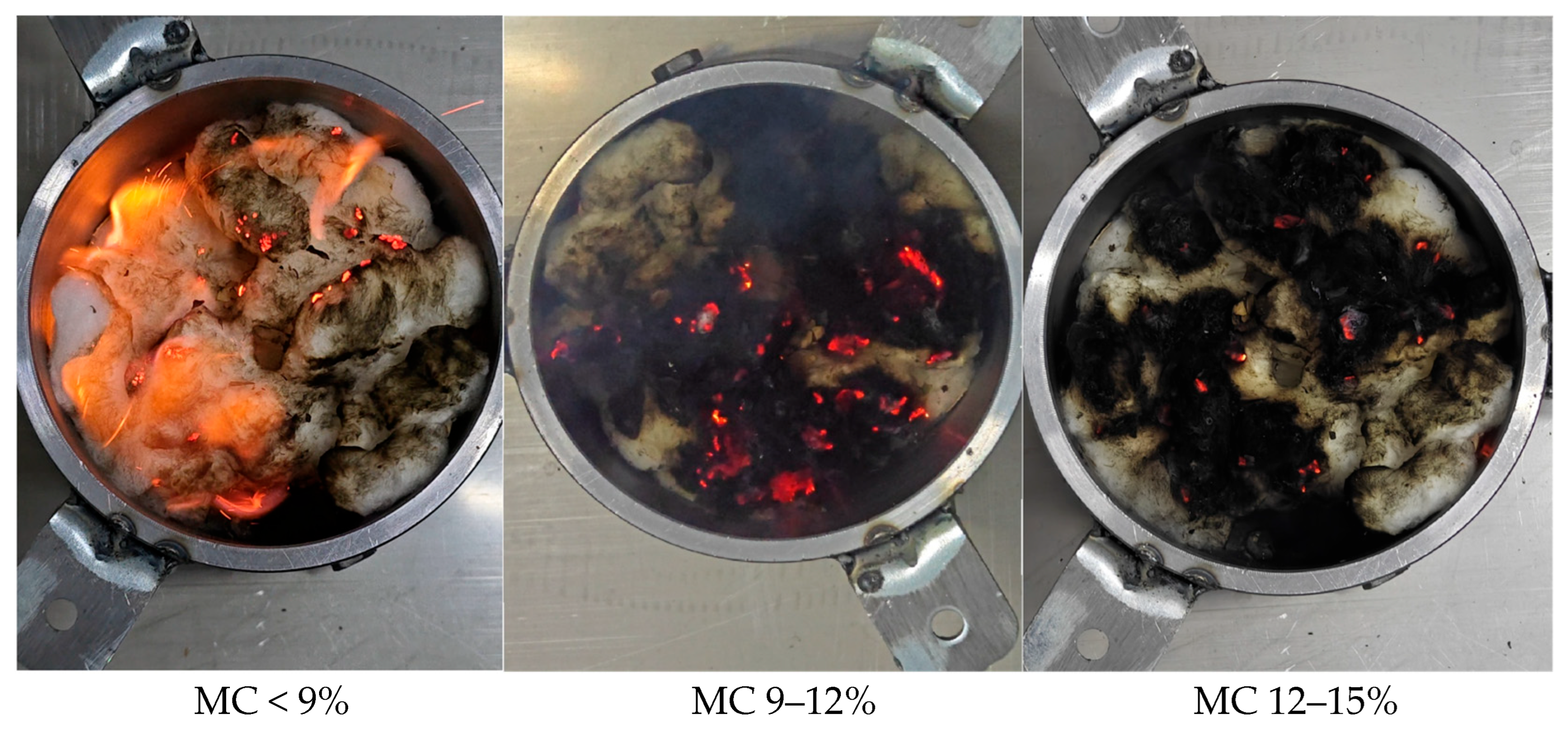


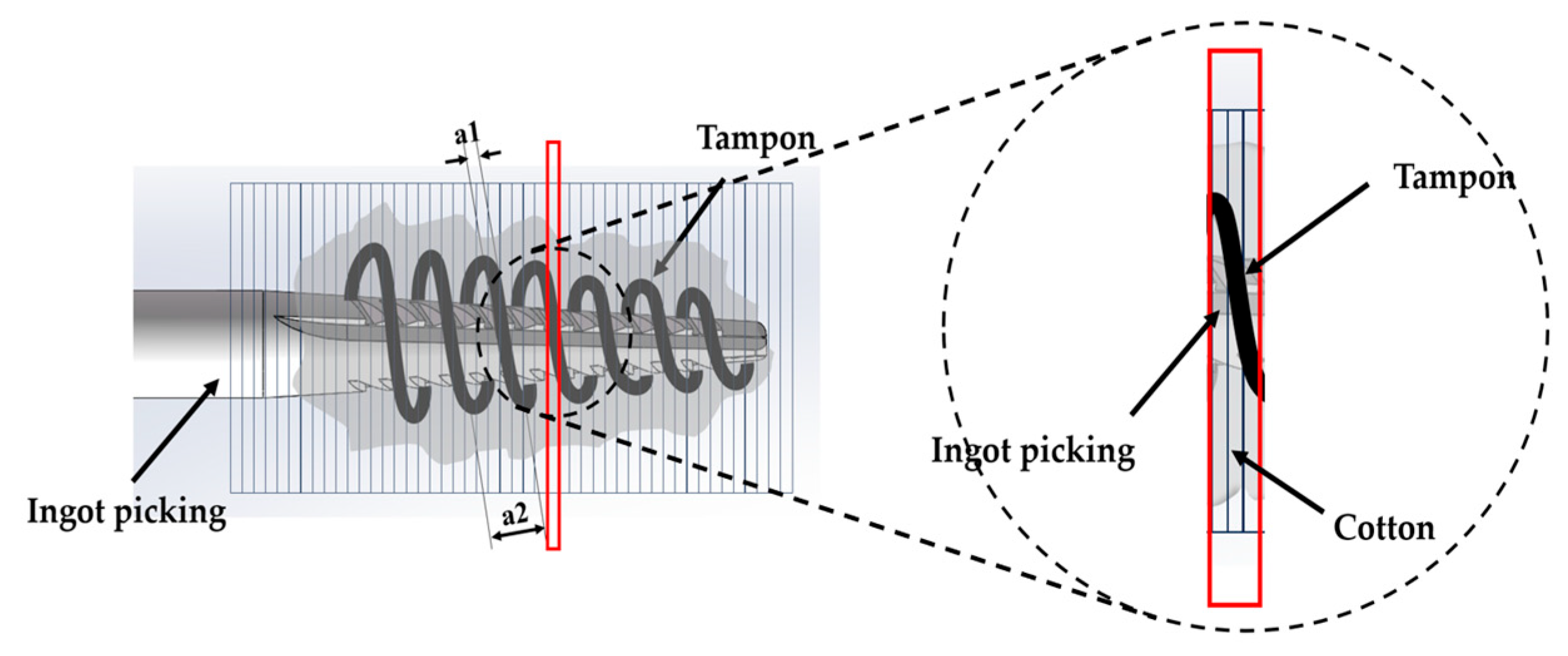

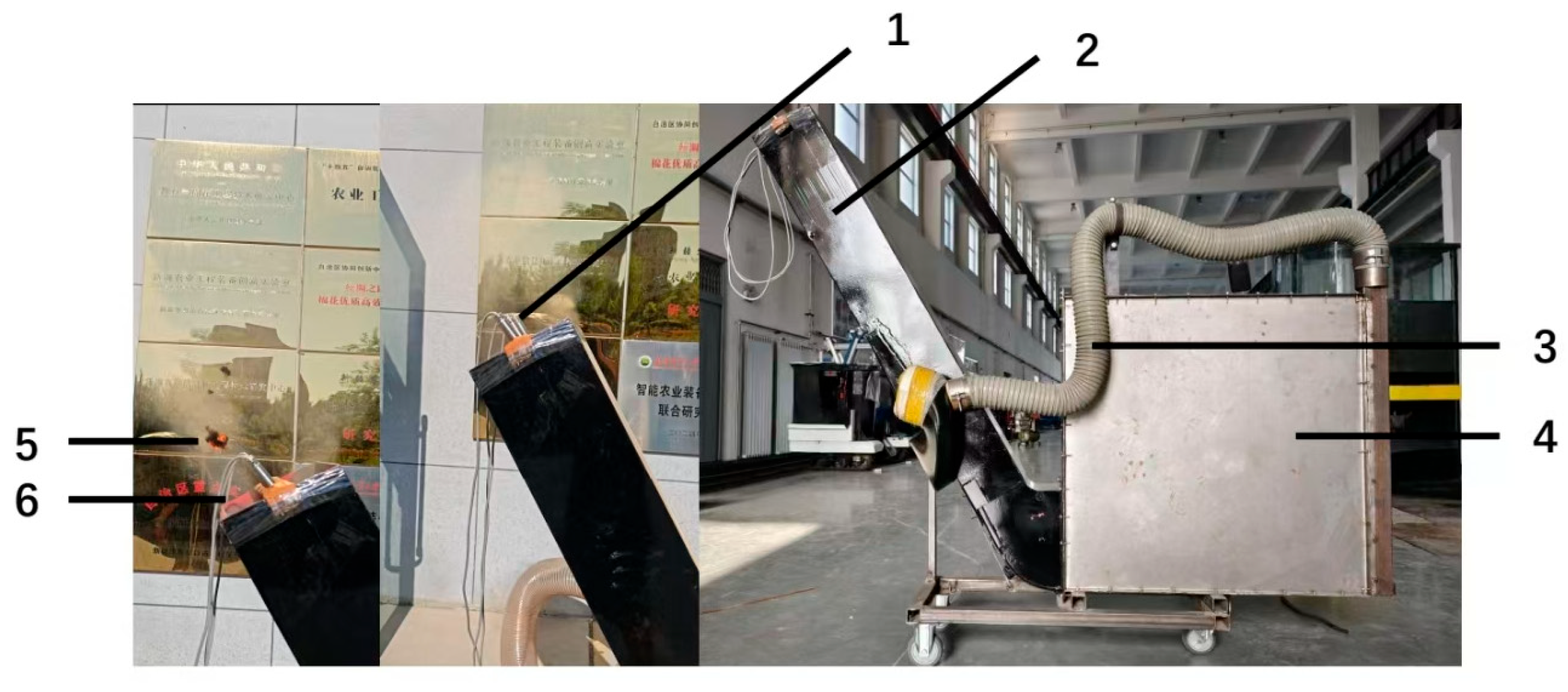



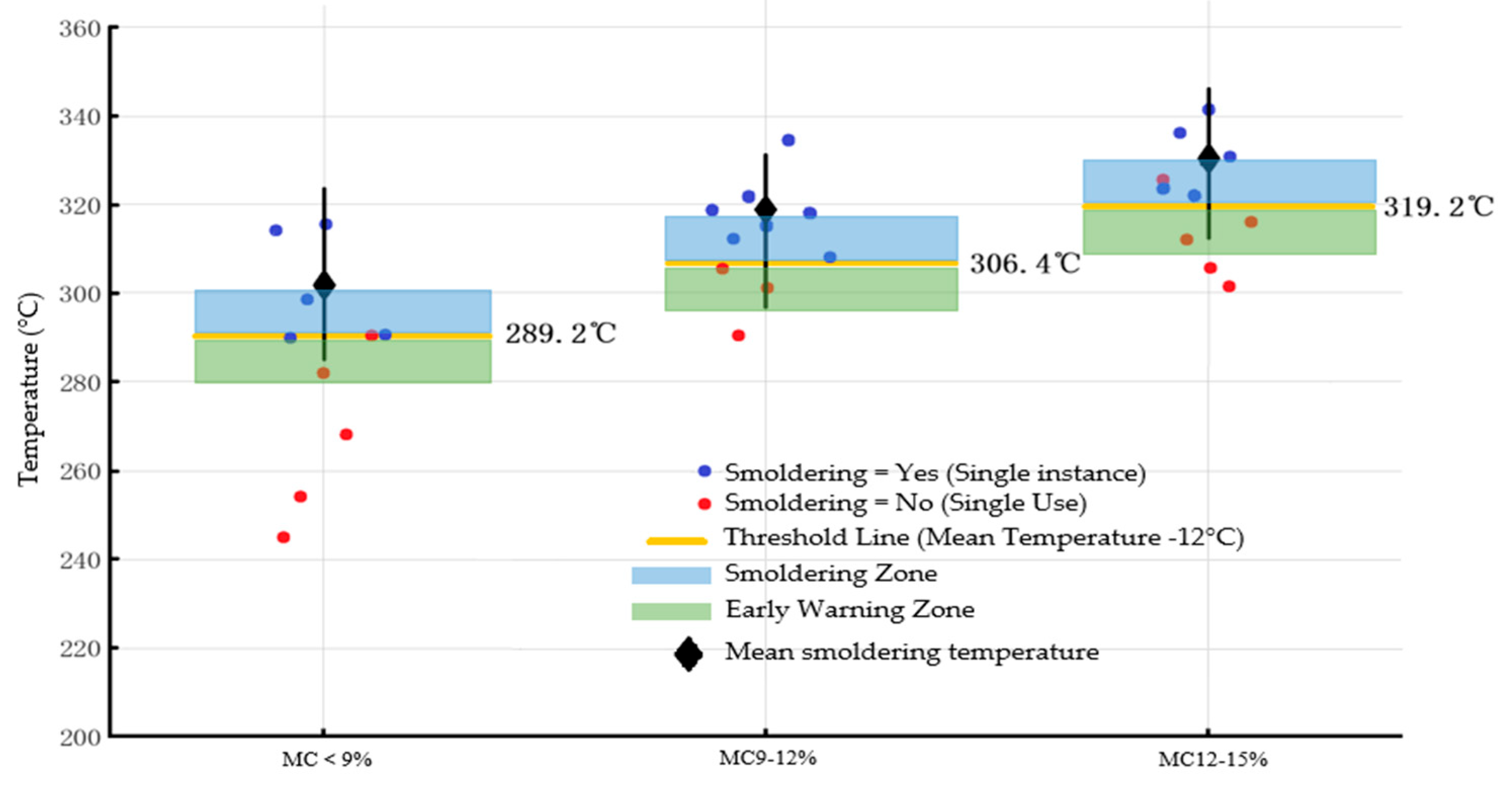

| Comparison Dimensions | Previously Mainstream Method Categories | Root Cause Analysis of High False Alarm Rates | Current Paper Methodology | Core Improvements for False Alarm Reduction |
|---|---|---|---|---|
| Threshold Setting Logic | Single Fixed Temperature. Threshold Method | The fire monitoring components use a uniform threshold that does not consider daily fluctuations in seed cotton moisture content affecting the ignition point, nor the varying heat generation characteristics of the picking head, cotton conveyor tube, and cotton bin. | Classified by components—picking head, cotton bin, and cotton conveyor—each category was studied at three threshold levels based on varying wet-basis conditions. | Thresholds are aligned with component characteristics and real-time humidity to prevent environmental adaptability issues. |
| Monitoring Sites and Parameters | Single-point or single-parameter monitoring method | Monitoring only the cotton feed tube or cotton bin overlooks the high-frequency hazard of friction at the picking head. | Multi-point and multi-parameter integrated monitoring covers critical components of the cotton picker, with temperature as the primary criterion and carbon monoxide as the secondary criterion. | Fill monitoring gaps, implement multi-parameter cross-validation, and reduce false triggers from environmental interference on single signals. |
| Sensor Adaptation to the Environment | Multi-sensor Fusion Method | Sensors lack proper protection, allowing dust to adhere to optical windows and high temperatures to cause sensitivity drift. Signal distortion results in false alarms. | Designed for harsh environments, the infrared sensor is dust-resistant and operates over a wide temperature range. The CO sensor includes a protective housing and a ventilation fan. | Sensor Selection and Hardware Protection: Improving Signal Reliability in Complex Field Environments. |
| Fire Situation Assessment Logic | Single-Signal Triggering Method | Temperature exceeding the threshold triggers an alarm but does not differentiate between high temperatures during normal operation and those indicating a potential fire hazard, increasing the likelihood of false alarms. | Temperature and CO levels trigger simultaneously, while the picking head temperature is combined with friction parameters. | Establish a correlation logic for operational conditions and parameters to eliminate interference signals during normal operations. |
| Visual Identification Support Solution | Traditional single-modal visual recognition methods (some systems) | Direct sunlight and equipment reflections cause saturation in infrared imaging, leading to a high false alarm rate. | A coupling model based on physical engagement conditions, independent of visual recognition. | Reduces optical interference defects to adapt to Xinjiang’s intense light and dusty conditions. |
| MC | MC < 9% | MC 9–12% | MC 12–15% |
|---|---|---|---|
| Operating conditions | Small flame contact for 0.3 s, ambient wind speed 3 m/s, medium packing density | Small flame contact for 0.3 s, ambient wind speed 3 m/s, medium packing density | Small flame contact for 0.3 s, ambient wind speed 3 m/s, medium packing density |
| Combustion state | Rapid combustion, sustained burning after removal from heat source | Rapid combustion, followed by slow smoldering after extinguishing | Flames flickered, with localized smoldering after the fire was extinguished. |
| Surface Temperature (Open Flame, °C) | 312 ± 3 | 243 ± 3 | 177 ± 3 |
| Surface Temperature (Smoldering, °C) | 229 ± 3 | 193 ± 3 | 162 ± 3 |
| Extinguishing Time (S) | 3.7 | 1.1 | 0 |
| Visible signs | The flames flicker, with less smoke. | Intermittent flames, multiple slow smoldering areas, heavy smoke | No flames, slow smoldering in localized areas, minimal smoke |
| Humidity | MC < 9% | MC 9–12% | MC 12–15% | ||||||
|---|---|---|---|---|---|---|---|---|---|
| Parameters | Surface Temperature (Open Flame, °C) | Surface Temperature (Smoldering, °C) | Extinguishing Time (S) | Surface Temperature (Open Flame, °C) | Surface Temperature (Smoldering, °C) | Extinguishing Time(S) | Surface Temperature (Open Flame, °C) | Surface Temperature (Smoldering, °C) | Extinguishing Time (S) |
| 1 | 312 ± 3 | 229 ± 3 | 3.7 | 243 ± 3 | 193 ± 3 | 1.1 | 177 ± 3 | 162 ± 3 | 0 |
| 2 | 325 ± 3 | 226 ± 3 | 4.1 | 282 ± 3 | 204 ± 3 | 0.4 | 184 ± 3 | 163 ± 3 | 0.2 |
| 3 | 366 ± 3 | 217 ± 3 | 3.6 | 279 ± 3 | 198 ± 3 | 0.3 | 176 ± 3 | 168 ± 3 | 0 |
| 4 | 314 ± 3 | 228 ± 3 | 3.4 | 245 ± 3 | 181 ± 3 | 1.2 | 171 ± 3 | 159 ± 3 | 0 |
| 5 | 329 ± 3 | 225 ± 3 | 3.4 | 259 ± 3 | 197 ± 3 | 1.3 | 180 ± 3 | 159 ± 3 | 0.4 |
| 6 | 308 ± 3 | 230 ± 3 | 2.7 | 277 ± 3 | 191 ± 3 | 0.9 | 177 ± 3 | 164 ± 3 | 0 |
| 7 | 315 ± 3 | 223 ± 3 | 4.6 | 299 ± 3 | 199 ± 3 | 1.5 | 187 ± 3 | 169 ± 3 | 0.3 |
| 8 | 342 ± 3 | 229 ± 3 | 3.9 | 253 ± 3 | 182 ± 3 | 1.7 | 182 ± 3 | 176 ± 3 | 0.1 |
| 9 | 282 ± 3 | 225 ± 3 | 2.7 | 247 ± 3 | 181 ± 3 | 1.6 | 178 ± 3 | 151 ± 3 | 0 |
| 10 | 351 ± 3 | 234 ± 3 | 3.1 | 235 ± 3 | 189 ± 3 | 1.3 | 172 ± 3 | 164 ± 3 | 0 |
| mean | 324.4 ± 3 | 226.6 ± 3 | 3.5 | 261.9 ± 3 | 191.5 ± 3 | 1.13 | 178.4 ± 3 | 163.5 ± 3 | 0.1 |
| Number of Tests | 1 | 2 | 3 | 4 | 5 | 6 | 7 | 8 | 9 |
|---|---|---|---|---|---|---|---|---|---|
| MC < 9% |  |  |  |  |  |  |  |  |  |
| Surface Temperature (°C) | 147 ± 3 | 181 ± 3 | 205 ± 3 | 237 ± 3 | 259 ± 3 | 272 ± 3 | 304 ± 3 | 319 ± 3 | 337 ± 3 |
| Is it smoldering | N | N | N | N | N | Y | Y | Y | Y |
| Smoldering time (s) | —— | —— | —— | —— | —— | 9 | 5.2 | 3.8 | 2.1 |
| MC 9–12% |  |  |  |  |  |  |  |  |  |
| Surface Temperature (°C) | 153 ± 3 | 172 ± 3 | 196 ± 3 | 204 ± 3 | 225 ± 3 | 260 ± 3 | 286 ± 3 | 306 ± 3 | 311 ± 3 |
| Is it smoldering | N | N | N | N | N | N | Y | Y | Y |
| Smoldering time (s) | —— | —— | —— | —— | —— | —— | 12.6 | 8.5 | 6.4 |
| MC 12–15% |  |  |  |  |  |  |  |  |  |
| Surface Temperature (°C) | 152 ± 3 | 181 ± 3 | 198 ± 3 | 217 ± 3 | 226 ± 3 | 263 ± 3 | 278 ± 3 | 301 ± 3 | 316 ± 3 |
| Is it smoldering | N | N | N | N | N | N | N | Y | Y |
| Smoldering time (s) | —— | —— | —— | —— | —— | —— | —— | 18.7 | 16.2 |
| Number of Times | 1 | 2 | 3 | 4 | 5 | 6 | 7 | 8 | 9 | 10 |
|---|---|---|---|---|---|---|---|---|---|---|
| MC < 9% |  |  |  |  |  |  |  |  |  |  |
| Is it smoldering | Y | Y | N | N | Y | N | Y | Y | N | N |
| Surface Temperature (°C) | 314.3 ± 2 | 288.7 ± 2 | 244.6 ± 2 | 252.4 ± 2 | 298.8 ± 2 | 280.9 ± 2 | 315.0 ± 2 | 289.0 ± 2 | 268.3 ± 2 | 288.8 ± 2 |
| MC 9–12% |  |  |  |  |  |  |  |  |  |  |
| Is it smoldering | Y | Y | Y | N | Y | Y | N | N | N | Y |
| Surface Temperature (°C) | 318.8 ± 2 | 312.4 ± 2 | 322.3 ± 2 | 314.8 ± 2 | 334.5 ± 2 | 318.7 ± 2 | 304.5 ± 2 | 290.6 ± 2 | 300.6 ± 2 | 307.1 ± 2 |
| MC 12–15% |  |  |  |  |  |  |  |  |  |  |
| Is it smoldering | Y | N | Y | Y | N | N | N | Y | Y | N |
| Surface Temperature (°C) | 323.0 ± 2 | 325.5 ± 2 | 334.4 ± 2 | 321.9 ± 2 | 311.2 ± 2 | 305.5 ± 2 | 301.1 ± 2 | 345.4 ± 2 | 331.5 ± 2 | 315.9 ± 2 |
| Humidity | MC < 9% | MC 9–12% | MC 12–15% |
|---|---|---|---|
| Simulated Cloud Map |  | 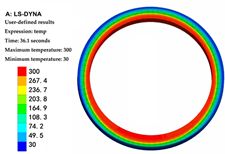 | 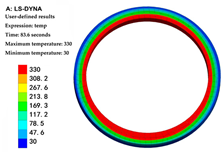 |
| Cotton seed temperature | 290 °C | 300 °C | 330 °C |
| Simulation time | 18.7 s | 36.1 s | 83.6 s |
| Number of Times | 1 | 2 | 3 | 4 | 5 | 6 | 7 | 8 | 9 | 10 |
|---|---|---|---|---|---|---|---|---|---|---|
| Unburned Seed Cotton Temperature (°C) | 27 ± 3 | 25 ± 3 | 28 ± 3 | 33 ± 3 | 26 ± 3 | 29 ± 3 | 27 ± 3 | 31 ± 3 | 35 ± 3 | 29 ± 3 |
| Combustion Temperature of Seed Cotton (°C) | 51 ± 3 | 49 ± 3 | 52 ± 3 | 55 ± 3 | 63 ± 3 | 59 ± 3 | 72 ± 3 | 62 ± 3 | 58 ± 3 | 63 ± 3 |
| Test Type | Ginned Cotton (MC) | Core Metrics | Average Temperature (°C) | Standard Deviation (SD, °C) | Coefficient of Variation (CV, %) | Analysis of Uncertainty Causes |
|---|---|---|---|---|---|---|
| Seed Cotton Open Flame Test | <9% | Surface Temperature of Burning | 324.4 | 3 | 0.92 | Low-moisture seed cotton burns intensely with stable peak temperatures, where errors stem solely from sensor accuracy (±3%) |
| 9–12% | 261.9 | 3 | 1.15 | Moist seed cotton burns with a flame that fluctuates intermittently, ranging from rapid open burning to slow smoldering | ||
| 12–15% | 178.4 | 3 | 1.68 | High-moisture seed cotton struggles to sustain open flames, easily extinguishing instantly, with the most significant fluctuations in temperature measurements. | ||
| Picking Head Friction Test | <9% | Smoldering Critical Temperature | 289.2 | 2 | 0.69 | Low-moisture seed cotton generates heat rapidly through friction, and its smoldering ignition temperature is stable. |
| 9–12% | 306.4 | 2 | 0.65 | Medium-moisture seed cotton exhibits a moderate rate of friction heat accumulation and the smallest variation in smoldering threshold (CV=0.65%), yielding the highest data reliability. | ||
| 12–15% | 319.2 | 2 | 0.63 | High-moisture seed cotton requires greater friction heat to initiate smoldering combustion, with a stable but overall elevated threshold. | ||
| Cotton Feed Pipe Wall Temperature Test | - | Combustion temperature of seed cotton walls | 58.4 | 3 | 5.14 | The highest dispersion occurs due to the difficulty in achieving uniform flow conditions (filling rate, flow velocity) of the seed cotton within the feed pipe, resulting in significant fluctuations in wall temperature measurements. |
| Input Parameters | Parameter Variation Rang | Output Indicator (Temperature Threshold T, °C) | Threshold Change (ΔT) | Sensitivity Coefficient (S) | Sensitivity Analysis Conclusions |
|---|---|---|---|---|---|
| Moisture Content (MC) of Seed Cotton | 8% → 15% | Harvesting threshold: 289 → 319 | +30 | 0.17 | The harvesting threshold increases by an average of 1.7 °C for every 1% increase in MC, suggesting considerable sensitivity. This is because heat is absorbed via moisture evaporation, which raises the ignition point, albeit gradually. |
| Spindle speed n | 3500 → 4300 r/min | Friction-generated heat temperature: 289 → 301 | +12 | 0.05 | The threshold barely increases by 5% for every 10% increase in rotational speed, suggesting a low sensitivity parameter. This happens because faster rotating speed increases frictional power while also speeding up heat dissipation, which partially counteracts thermal accumulation. |
| Normal load Fn | 3000 → 12,000 N | Friction-generated heat temperature: 275 → 330 | +55 | 0.61 | The threshold increases by 6.1% for every 10% increase in Fn, making it an extremely sensitive metric. A sharp increase in Fn during cotton obstruction leads to an exponential rise in friction-generated heat, which is the primary source of smoldering combustion. |
| Component | Core Monitoring Signals | Moisture Content of Seed Cotton (MC, %) | Recommended Threshold (°C) | Key Notes |
|---|---|---|---|---|
| Cotton box | Infrared Radiation (Surface Temperature of Raw Cotton) | <9 | 240 | Risk of smoldering |
| 9–12 | 240 | |||
| 12–15 | 280 | |||
| Harvesting Head | Infrared Radiation (Temperature at the Contact Interface Between Seed Cotton and the Picking Head) | <9 | 289 | Risk of thermal runaway caused by friction-induced heat generation |
| 9–12 | 306 | |||
| 12–15 | 319 | |||
| Cotton Feed Tube | Primary criterion: CO concentration | __ | 49 | Must be interlocked with the CO concentration threshold (>50 ppm) |
| Auxiliary criterion: pipe wall temperature |
Disclaimer/Publisher’s Note: The statements, opinions and data contained in all publications are solely those of the individual author(s) and contributor(s) and not of MDPI and/or the editor(s). MDPI and/or the editor(s) disclaim responsibility for any injury to people or property resulting from any ideas, methods, instructions or products referred to in the content. |
© 2025 by the authors. Licensee MDPI, Basel, Switzerland. This article is an open access article distributed under the terms and conditions of the Creative Commons Attribution (CC BY) license (https://creativecommons.org/licenses/by/4.0/).
Share and Cite
Shi, Z.; Song, D.; Han, C.; Wu, F.; Wu, Y. Cotton Picker Fire Risk Analysis and Dynamic Threshold Setting Using Multi-Point Sensing and Seed Cotton Moisture. Agriculture 2025, 15, 2165. https://doi.org/10.3390/agriculture15202165
Shi Z, Song D, Han C, Wu F, Wu Y. Cotton Picker Fire Risk Analysis and Dynamic Threshold Setting Using Multi-Point Sensing and Seed Cotton Moisture. Agriculture. 2025; 15(20):2165. https://doi.org/10.3390/agriculture15202165
Chicago/Turabian StyleShi, Zhai, Dongdong Song, Changjie Han, Fangwei Wu, and Yi Wu. 2025. "Cotton Picker Fire Risk Analysis and Dynamic Threshold Setting Using Multi-Point Sensing and Seed Cotton Moisture" Agriculture 15, no. 20: 2165. https://doi.org/10.3390/agriculture15202165
APA StyleShi, Z., Song, D., Han, C., Wu, F., & Wu, Y. (2025). Cotton Picker Fire Risk Analysis and Dynamic Threshold Setting Using Multi-Point Sensing and Seed Cotton Moisture. Agriculture, 15(20), 2165. https://doi.org/10.3390/agriculture15202165





